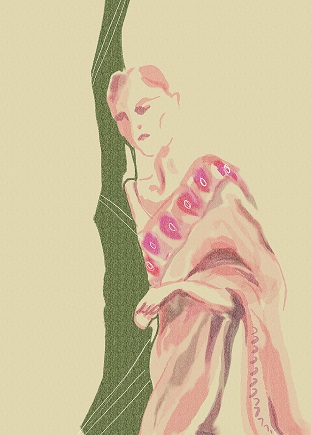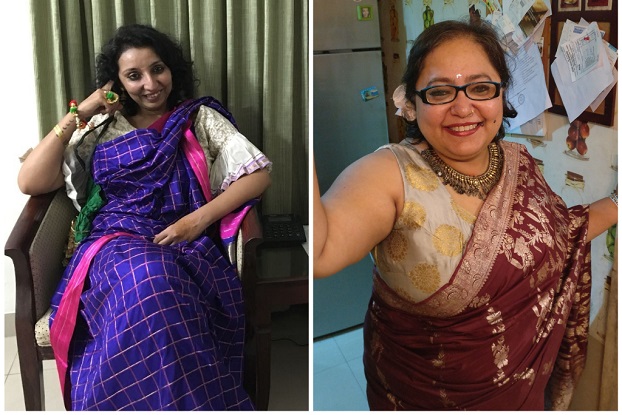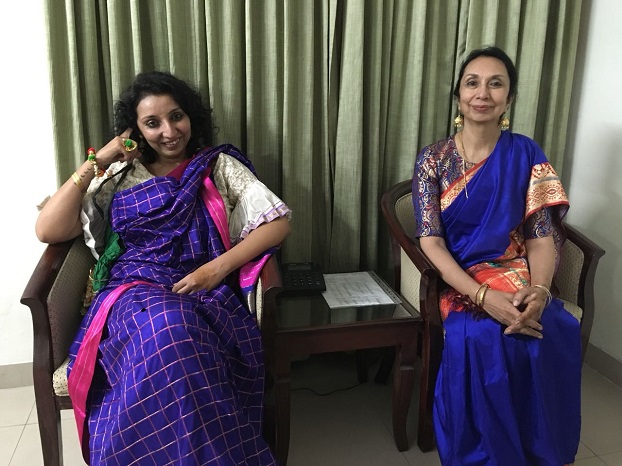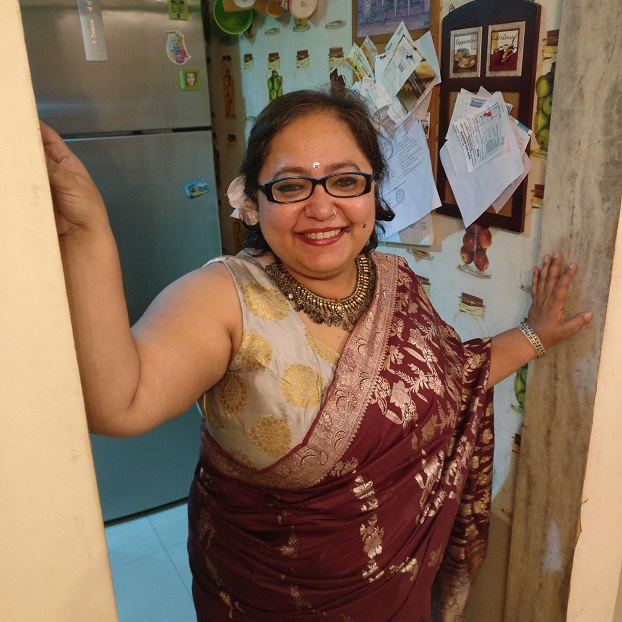
How the drape holds meaning and memory for the desi mind, body, and soul. A series of interview-vignettes, showcasing uber serious sari love, brought out via passion, history, politics, through interviews with people across the spectrum who love to drape it, and also, talk about it! (Read Chapter One for the interview with Laila Tyabji, impassioned crafts activist and co-founder of Dastkar.)
* * *

Sari chatter across two cities, with two filmmakers.
“6 yards of cloth worn by multiple women in the same family, in their own way. No other garment does that, no?” – Shabani Hassanwalia
“All this politics in saris, I’m like #borematkaryaar… You should dress to be joyful, to express yourself. Dress with what you can afford.” – Paromita Vohra
* * *
“My nani would design her own saris with her own weaver and printer. Man, she would’ve gone nuts at Dastkar’s exhibitions!” Shabani Hassanwalia, 37, Delhi-based documentary filmmaker, puts the women of her family right at the center of the sari charcha, because to her, it’s always been about “mothers, their mothers, and their mothers…”
She goes on, illuminating the “sari-as-memory-site” thought. “I don’t think I’ve touched an old sari from my mom’s cupboard without a story tumbling out of its folds. ‘Your nani gave this to me when I got my first salary of Rs. 120 rupees’; ‘Your nana bought this Dhakai because he loved clothes. And he never bought one sari. He always bought four. For his wife and three daughters’. When we go to our ancestral home in Jalandhar, we look at old black and white photographs and try and identify the sari nani is wearing from what we have at home. And then what she must have done before she tied the sari. What she must have done after the photo was taken.”
I’ve never met my dadi. But I feel I know her because of the saris she wore, which my mom has.
It has helped Shabani with imagining histories and origins too, “I’ve never met my dadi. But I feel I know her because of the saris she wore, which my mom has. I have a sense of her because she was someone who would wear grand chiffons when she went to play bridge at the club.” She adds, importantly, “I can never, and have never worn a chiffon even if my life depended on it.”

Do we all carry some sari no-no’s then? Does it carry some of our inhibitions too, along with our stories? While Shabani discovered saris in her mid-20s, Mumbai-based documentary filmmaker Paromita (“Paro”) Vohra, 49, also founder of the Agents of Ishq, only started wearing them regularly about two years ago. “A friend of mine said to me the other day, ‘Sari has come to you in your late age like a lover’,” she says, laughing, as we attempt to unpeel the layers of that thought over a What’s App call.
While Paro, like all of us, recalls the first sari she ever wore, “a red wine sari with a black and gold border, I must have been about 12 or 13”, she also remembers not admiring herself in the mirror. “I grew up thinking of myself as unattractive. Sari is always been considered a feminine dress and I was never a feminine person by strict convention. Being fat, I felt I would look fatter wearing them. Saris belonged to that world of femininity and since I didn’t belong to that world, I thought it wasn’t for me.”
Saris belonged to that world of femininity and since I didn’t belong to that world, I thought it wasn’t for me.
It did her some damage (“I just came to the conclusion that being feminine isn’t allowed to me”), but Paro being Paro does not paint you any wounded backstories, choosing instead to speak of the journey she has made as “a straight, queer woman”. “I’m a femme type person”, she says, even as I’m tempted to add fatale, “but diverse meanings of femininity were not available to me then.”
Paro breaks up the lifetime’s journey — “the opportunity to travel, define my own relationships, and be part of very complex, intricate web of relationships that at times have no obvious, straightforward, accepted, conventional definitions” — that has led her where she is today. A familiar sight at panels and seminars rocking yet another gorgeous sari, exuding beauty, wit, and intelligence, a flower tucked behind one ear.

There is also this notion of wearing saris perfectly. Or having to wear them perfectly. Else, god help you. Something Shabani associates with her mum, “I always used to feel that I’m not good enough for the sari I’m wearing, mostly because I don’t have the grace my mother does. The same saris that wrap around her like a cloud, wrap around me like a sack.” And even though the feeling lingers on, “I’ve only ever wanted to look like her in a sari. I think she came out of the womb in a Chanderi.…”, a few things do shift over time. Urging you to ask — But then? “But then”, says Paro, “you also meet people and make friends and see them doing things differently, wear saris imperfectly, and you think it could be for you also.”
Says Shabani of her own journey, “At some point in my 20s, probably at the same time when I started feeling less as an imposter in life in general, I thought hey, it’s 6 yards of cloth! I can do whatever I want! And now, I tie it the way I like (chhota pallu, with a belt, ankles showing) and I really don’t feel as alive wearing anything else.”
What has the transition been like, as viewed by these two observant, sharp women who practice an art form steeped in the visual, we wonder?
Says Paro, tongue firmly in cheek, “Now of course, unconventional is conventional. It’s so very hard to be unconventional these days — everybody’s so DP [display picture/profile picture]-type to un-convention.” She tells us about her social gatherings, which have friends of many different ages in attendance, “This friend of mine said to me, how the younger women have such a masterful vocabulary of fashion — everyone has a look, and they look very, very good. But the older women have a unique style of dressing, that is all their own. And I found that to be true.”
I thought hey, it’s 6 yards of cloth! I can do whatever I want!
Meanwhile, Shabani finds herself wishing the sari was more normalized, and not only at parties, “I know I’d wear a sari way more if it didn’t bring so much attention to me, if everyone around me wore it casually, if it wasn’t a conversation starter.” This is why she usually wears saris to formal or semi-formal events, though the definition of those has undergone evolution — today Shabani would wear a sari to a meeting too, not just to the family dinner, where they often discuss the disappearance of the sari, “Well, in malls, we notice how no one wears saris anymore, and there’s a collective sigh, like there must’ve been in the writer circle when they first noticed that no one uses typewriters anymore.”
Paro has a clear view of the agendas behind saris, or indeed, what you wear on your body, that is, she does not care for them. “Sari ko political banana is so boring, ya. For me, beautiful is very important. I feel depressed without beauty. And I find duty most oppressive. So, beauty before duty! And all this politics in saris, I’m like #borematkaryaar. You should dress to be joyful, to express yourself, dress with what you can afford… Yes, I think it’s entertaining to wear a Mallu sari and go out to eat an Onam feast. But that’s entertainment. Otherwise, this ‘I must wear a sari on Women’s Day’, it’s not like that for me. Woh ho gaya na uniform wala school mein.”
When we’re done laughing, Paro adds her view on the importance of appearance, “I’m not someone who wears jeans to a shaadi and thinks I’m very cool. When I went to Afghanistan, because they invited me for a women’s film fest, I covered my head because they’d asked me to. If I was living there, my journey would’ve been very different — I would navigate my own journey, the way I have here, to be true to myself.” She also makes the political personal when she says, “The idea of khadi as a political dress is rooted in a larger political and economic context. As for responding strongly to Sabya’s comment, please! The day his sari costs 2000 or under, I’ll care about what he says.”
Until then, Paro would like to add a caveat to the whole ‘I-dress-for-myself’ stance, “I don’t know about that, I dress as myself, I’d say, and I have many selves, so whichever self it is that day. And I also most definitely dress to charm other people. I always dress better when I’m going to meet my lady friends, for instance — because they enjoy it, and I enjoy that they enjoy it. When people respond, you like to dress for that response. It’s like when people enjoy watch[ing what] you make, or what you write… So, I share the pleasure of dressing with other women and a few good men.”
Saris, like all garments that indicate class and money-power, of course carries with it a sense of caste.
As for mothers and memories, Paro would agree with Shabani, and she shares her lovely story of mum’s cupboard of saris, “…so my mum’s doli ki sari, a Banarasi silk, yellow, with ears of corn — a lovely sari, but she hated it. So, she had it dyed wine red — but then the zari became silver from gold, so she hated it even more, she wanted to make a razai out of it! Now, I remember this sari so well — as a kid, I used to love my mum’s cupboard of saris, I’ve seen them being packed, put away, as we moved houses, so many houses, I used to love the whole business of her wearing the saris, I would watch her wear them — I rediscovered the doli ki sari on Diwali this year and I wore it. I was very over-dressed, but who the fuck cares!”
Shabani’s current favorite sari is a black malmal designer sari, though it might have changed by the time you read this, and she deeply misses conversations around “the gold and white Kerala lungi set”, the male counterpart to the sari, she thinks. As for politics, Shabani likes the disruption for now, or at least the possibility of it, “Saris, like all garments that indicate class and money-power, of course carries with it a sense of caste. An aunt remarked recently on the now trending Gamcha Sari and how it’s just ‘worker wear’, and why would anyone turn it into a sari for ‘women like us’? It made me buy a Gamcha Sari the very next day.”
Moving on from disruption to poetry, meet Jaya & Swaati, Odissi dancers, proud sari wearers in Chapter 3: Sari Sisters. Up next!
* * *
Pooja Pande is a writer-editor who grew up in, considers home, and hence has a suitably complex love-hate relationship with the capital city of India, Delhi. Her first book is Red Lipstick, a literary-styled memoir on celebrity transgender rights activist Laxminarayan Tripathi. Find her on Twitter at @derrindo.












